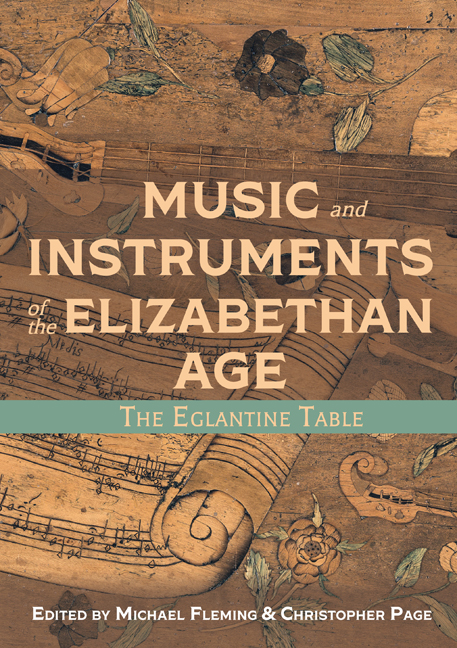Book contents
- Frontmatter
- Dedication
- Contents
- List of Illustrations
- Foreword
- Acknowledgements
- Note to the Reader
- List of Abbreviations
- Introducing the Eglantine Table
- Part I Silent Things
- Part II Music and Instruments
- Part III Broader Views of the Eglantine Table
- Appendices
- Glossary
- Bibliography
- List of Contributors
- Index
- Plate section
11 - The Lute
Published online by Cambridge University Press: 24 March 2021
- Frontmatter
- Dedication
- Contents
- List of Illustrations
- Foreword
- Acknowledgements
- Note to the Reader
- List of Abbreviations
- Introducing the Eglantine Table
- Part I Silent Things
- Part II Music and Instruments
- Part III Broader Views of the Eglantine Table
- Appendices
- Glossary
- Bibliography
- List of Contributors
- Index
- Plate section
Summary
The depiction of a lute on the Eglantine Table is one of the most intriguing representations of the instrument from Tudor England (frieze A, Plates 2 and 8). That it is based on an actual instrument of the time seems likely (though some features may have been corrupted or improvised by the designer and craftsmen): on the treble side the string length is 616 mm, the length of the belly is 423 mm and its width at the widest point is 267 mm – dimensions that are quite credible for a lute represented at actual size. In contrast to the guitar, and some other instruments shown on the Table, a notable attempt has been made to comply with the rules of perspective, especially in the details of the bridge and neck. However, the tilt that allows the ribs to be viewed is not consistent with the untilted front; moreover, the pegbox is drawn to be congruent with the tilt that allows the ribs to be seen, but the belly of the instrument is not observed from the same angle of view. Another, similar, distortion explains the discrepancy between the string length at the bass and treble ends. In further contrast to most of the other instruments, the lute is richly supplied with decorative features, particularly on the neck, pegbox and capping strip (glued over the ends of the ribs, at the base of the instrument, to strengthen an area that would otherwise be weak – here it is inlaid with sweet briar or eglantine). The belly has an incomplete circle of eglantine and various other plants surrounding the bridge, rose and strings; a leaf that extends over the edge of the belly to the left of the rose shows that these floral slips do not represent inlay on the body of the instrument but are intended to give the impression of foliage that has been decoratively strewn on the instrument's front. The effect is a garland on the lute's belly that may indicate the cultural importance of the instrument (though it should be noted that the bagpipe is decorated in a similar way).
- Type
- Chapter
- Information
- Music and Instruments of the Elizabethan AgeThe Eglantine Table, pp. 161 - 170Publisher: Boydell & BrewerPrint publication year: 2021

